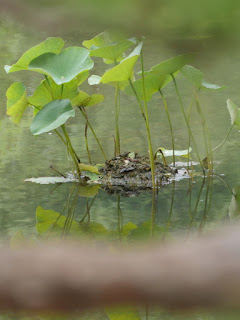ハナショウブといえば湿地に群生で咲く光景が思い出されますが、土壁をバックにするのも日本情緒が感じられます。
Speaking of Hanashobu, they remind me of the sight that bloom as a group at marshy place, but it also feels Japanese atmosphere to have a clay wall at the back.
2019年6月30日日曜日
2019年6月29日土曜日
浮葉植物 floating-leaved plant
2019年6月28日金曜日
知らない花 unknown name flower
名前のわからない一輪の花が、草むらの中に立ち上がっていました。
全世界で咲く花の数は、数十万を超えるそうです。
The unknown name flower was standing up in the grass.
They say the number of flowers in the world are exceed hundreds of thousands.
全世界で咲く花の数は、数十万を超えるそうです。
The unknown name flower was standing up in the grass.
They say the number of flowers in the world are exceed hundreds of thousands.
2019年6月27日木曜日
ヤマモモ酒 red bayberry liquor
ヤマモモが道路に沢山落ちていました。苦労もせず収穫ができ、さっそく焼酎に漬け込みました。レシピはいい加減です。氷砂糖も大きすぎのようです。偶然は新たな喜びを呼ぶかもしれません。これから3ヶ月ほど床下で寝かせます。
ところで、ヤマモモに触れるのは、はじめてなのですが、ほんのりと杉の香がしました。
Lots of red bayberry fruits have fallen on the road. So I could harvest them without any kind of hardships. And I pickled them in distilled spirits and glacial sugar right away. The recipe is not very precise. The glacial sugar seems too big. But fortuity may bring an unexpected pleasure. They are going to sleep for about three months under a floor.
By the way, it is the first time to touch red bayberry, but it has the slightly scent of cedar.
ところで、ヤマモモに触れるのは、はじめてなのですが、ほんのりと杉の香がしました。
Lots of red bayberry fruits have fallen on the road. So I could harvest them without any kind of hardships. And I pickled them in distilled spirits and glacial sugar right away. The recipe is not very precise. The glacial sugar seems too big. But fortuity may bring an unexpected pleasure. They are going to sleep for about three months under a floor.
By the way, it is the first time to touch red bayberry, but it has the slightly scent of cedar.
2019年6月26日水曜日
イトトンボ Damselfly
写真下側の2匹のイトトンボは交尾中です。先頭がオスで次がメス。オスの尾部がメスの頭の後ろをしっかり捕まえ、メスは尾部を雄の腹に結合します。横から見ると、この2匹はハート型になっています。オスと思われる3匹目が後ろから近づいてきました。一瞬、一対のイトトンボが動いたと思ったら、3匹目はどこかへ行ってしまいました。
At the bottom of this photo, the two damselflies are under copulation. The head is male and the next is female. The male tail holds the back of the female head firmly, and the female tail joins to the male belly. Viewed from the side, they looks heart shaped.
The third damselfly which seems to be male is approaching from behind. In a moment, when I thought that a pair of damselfly moved, the third one went somewhere.
At the bottom of this photo, the two damselflies are under copulation. The head is male and the next is female. The male tail holds the back of the female head firmly, and the female tail joins to the male belly. Viewed from the side, they looks heart shaped.
The third damselfly which seems to be male is approaching from behind. In a moment, when I thought that a pair of damselfly moved, the third one went somewhere.
2019年6月25日火曜日
抱卵 incubation
カイツブリのつがいが、卵を温めています。均等に温めるため卵を時々回転させます。雌雄が交代で抱卵していますが、両者とも巣を離れるときは、卵に葉をかけて隠します。何処からそんな知恵が生まれるのでしょう。
A couple of grebes are warming their eggs. They occasionally rotate the eggs to warm evenly. Mother and father heat the eggs by turns. When the both of them leave the nest, they hide the eggs with a leaf. I wonder how do they have got the wisdom?
A couple of grebes are warming their eggs. They occasionally rotate the eggs to warm evenly. Mother and father heat the eggs by turns. When the both of them leave the nest, they hide the eggs with a leaf. I wonder how do they have got the wisdom?
 |
| 抱卵 little grebe warm eggs |
 |
| 回転 rotate eggs to warm evenly |
 |
| 葉で覆う cover eggs with leaf |
 |
| すぐ戻る I'll back soon |
 |
| 隠れて撮影 these photos taken from hiding place |
2019年6月24日月曜日
コウヤカミツレ Dyer's chamomile
和名の「コウヤカミツレ」は、「紺屋カミツレ」からきた名前で、その意味は「染物屋のカモミール」という意味です。英名とぴったり一致するのが面白いですね。コウヤカミツレは、草木染めに利用されるそうです。布がどのような黄色に染まるのか見てみたいものです。
The Japanese name "コウヤカミツレ" comes from "紺屋カミツレ", which means "Dyer's chamomile: chamomile of dyer." It is interesting that both names match exactly. It seems to be used as vegetable dyeing. I would like to see what kind of yellow the cloth is dyed.
The Japanese name "コウヤカミツレ" comes from "紺屋カミツレ", which means "Dyer's chamomile: chamomile of dyer." It is interesting that both names match exactly. It seems to be used as vegetable dyeing. I would like to see what kind of yellow the cloth is dyed.
登録:
投稿 (Atom)





